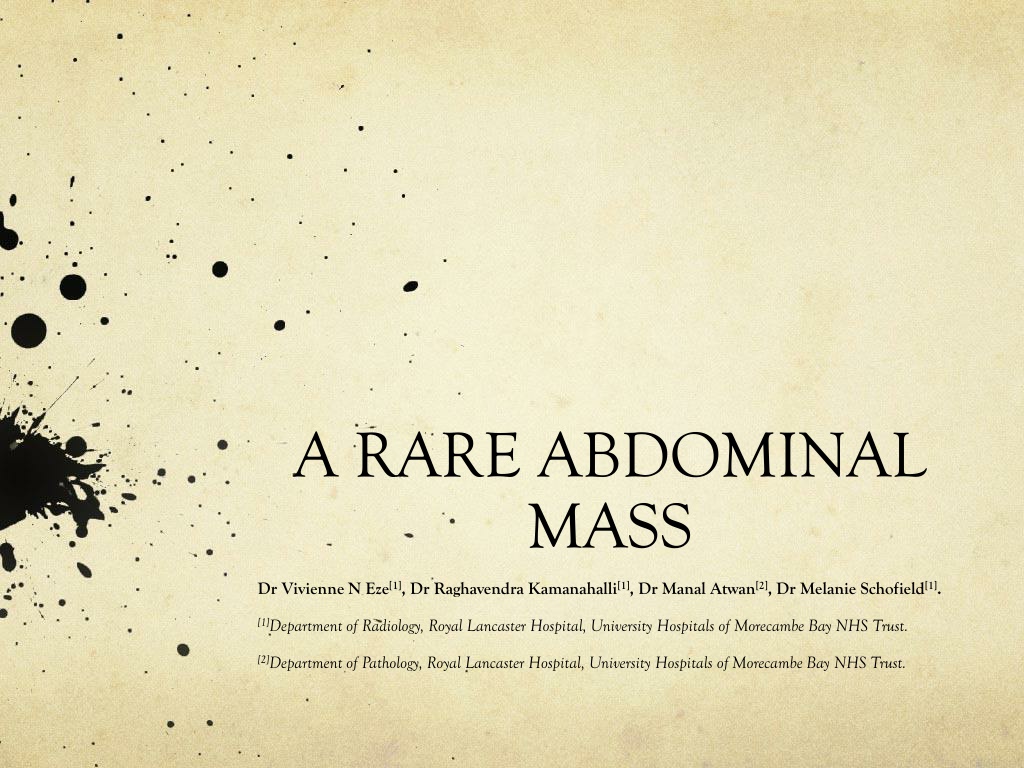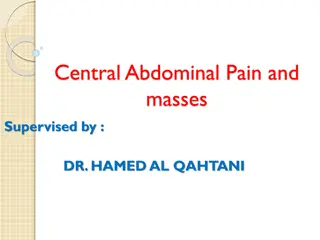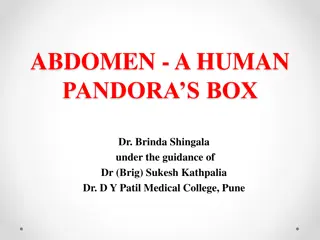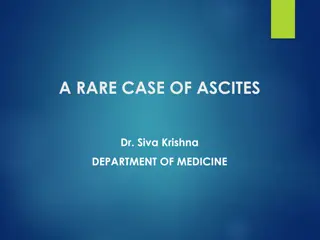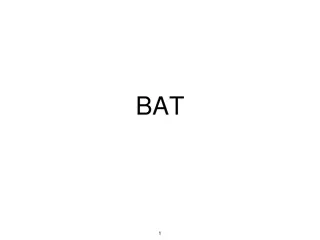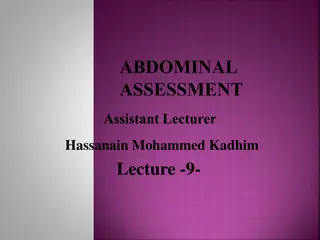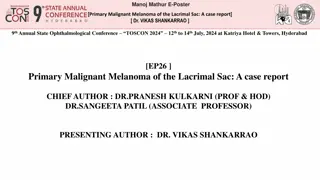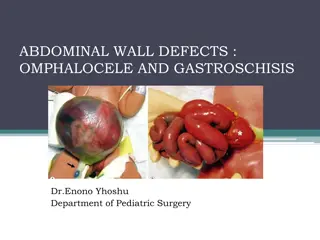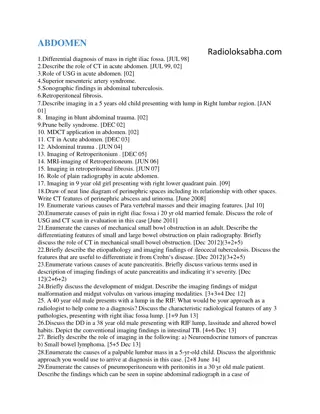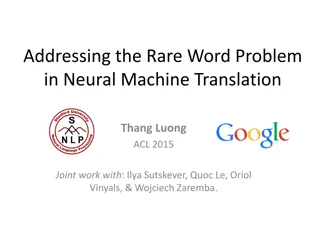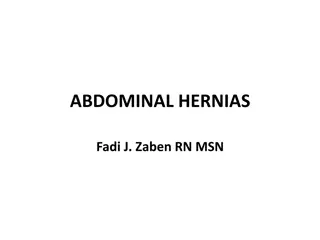A Rare Abdominal Mass: Clinical Presentation and Diagnosis
A 54-year-old woman with microscopic haematuria and raised inflammatory markers underwent imaging studies revealing a rare sclerosing angiomatoid nodular transformation of the spleen. The differential diagnosis, radiological features, histological confirmation, and learning points of this condition are discussed in detail.
Download Presentation

Please find below an Image/Link to download the presentation.
The content on the website is provided AS IS for your information and personal use only. It may not be sold, licensed, or shared on other websites without obtaining consent from the author. Download presentation by click this link. If you encounter any issues during the download, it is possible that the publisher has removed the file from their server.
E N D
Presentation Transcript
A RARE ABDOMINAL MASS Dr Vivienne N Eze[1], Dr Raghavendra Kamanahalli[1], Dr Manal Atwan[2], Dr Melanie Schofield[1]. [1]Department of Radiology, Royal Lancaster Hospital, University Hospitals of Morecambe Bay NHS Trust. [2]Department of Pathology, Royal Lancaster Hospital, University Hospitals of Morecambe Bay NHS Trust.
CLINICAL INFORMATION CASE PRESENTATION A 54-year-old woman was referred for a routine outpatient ultrasound scan for microscopic haematuria and raised inflammatory markers. She reported feeling well otherwise. PAST MEDICAL HISTORY: Nil significant INVESTIGATIONS: ESR 98mm, CRP 24.9 mg/L, WBC 11.4 10^9/L o Raised urea and creatinine o FBC, LFTS, TFTS and Bone profile. o No abnormal bands on protein electrophoresis and nuclear antigen screen was negative for common antigens ( Ro, La, SM, RNP, Jo-1, Scl 70). o Slightly raised IgG levels of 17.88 g/L (6.00-16.00). o
Figure 2: A: T1 weighted image showing a hypointense lesion in the spleen. B: T2 weighted image showing a hypointensed splenic lesion. C and D: Diffusion weighted and ADC sequences showing no restriction. Figure 1: A and B Abdominal ultrasound showing hypoechoic lesion close to the spleen. C and D- CT abdomen showing well- circumscribed low density lesion in the spleen. Figure 3: A, B and C: T1 Vibe fat-supressed (water signal only) images at 20s, 65s and 3 minutes respectively images showing progressive enhancement on delayed sequences. D,E and F: T1 Vibe subtracted images showing progressive enhancement Figure 4:A: Macroscopic section of resected spleen. B -E: Microscopy showing multinocular tumour with internodular stroma consisting of scattered plump myofibroblasts, siderophages and plasma cells
DIAGNOSIS SCLEROSING ANGIOMATOID NODULAR TRANSFORMATION OF THE SPLEEN CONFIRMED ON HISTOLOGY
LEARNING POINT Sclerosing Angiomatoid Nodular Transformation of Spleen (SANT) should be considered in the differential diagnosis of solid intra-splenic masses on CT and MRI. Low T2 signal helps to differentiate it from other vascular masses such as haemangioma or hamartoma. It is important to note however, that the diagnosis of SANT is still primarily a histological one.
DISCUSSION EPIDEMIOLOGY, PRESENTATION AND PATHOGENESIS RADIOLOGICAL FEATURES The aetiology of SANT is unclear and so far, it has only been described in adults between the second and seventh decade of life. The mean age described by the initial study by Martel et al was 48.4years and there appeared to be an increased incidence in women compared to men (2:1) [8]. Contrast enhanced ultrasound (CEUS) spoke-wheel-like enhancement- likely to represent the histological finding of the stellate appearance of the fibrous interstitium- and is thought to be characteristic of SANT [3]. Uptake of contrast by the periphery of the mass in the post vascular phase reflecting the presence of reticuloendothelial cells [3]. Mostly asymptomatic/incidental [1-8]. There have however been some reports of presentation with abdominal discomfort[4,6] Prior to being described as a distinctive pathology, it was known as cord capillary haemangioma, multinodular haemangioma or haemangioepithelioma [3,5]. It is benign in nature. PATHOLOGICAL FEATURES Computed Tomography (CT) Solitary, round, low-density lesions with progressive peripheral enhancement on delayed phase images similar to hepatic haemangiomas[3,5]. Peripheral enhancing radiating lines and rim enhancement on arterial phase of contrast enhanced CT which corresponded to histological concentration of angiomatoid nodules around the lesion in a radiating pattern [1,3]. Macroscopically, the lesion is usually a solitary, unencapsulated, well demarcated lesion with dark brown nodules within a dense fibrous stroma [7, 8] . Microscopically, the nodules appear dense and slit-like vascular spaces with some nodules also surrounded by rings of dense collagen fibres [7,8]. Numerous red blood cells, inflammatory cells, myofibroblasts, plasma cells and lymphocytes are also seen within the stroma. Mitotic figures, necrosis and nuclear atypia however are seldom seen [7,8] . Magnetic Resonance Imaging (MRI) Isointense on T1-weighted images and low signal intensity on T2-weighted images [1,5]. Immunostaining has shown the presence of 3 types of blood vessels; capillaries, sinusoids,and small veins[8]. The presence of these features distinguishes it from other types of haemangiomas and haemangio-epitheliomas and defines it as a separate entity [8].
REFERENCES Lewis R.B, Lattin G.E Jr, Nandedkar M and Aguilera N.S. Sclerosing angiomatoid nodular transformation of the spleen : CT and MRI features with pathologic correlation. AJR Am J Roentgenology 200: W353-W360. Murthy V, Miller B, Nikolousis E.M, Pratt G, Rudzki Z. Sclerosing angiomatoid nodular transformation of the spleen. Clinical case reports 2015; 3(10): 888-890. Watanabe M, Shiozawa K, Ikehara T, Kanayama M, Kikuchi Y, Ishii K, et al. A case of sclerosing angiomatoid nodular transformation of the spleen: correlations between contrast- enhanced ultrasonography and histopathologic findings. J Clin Ultrasound. 2014;42(2):103 7. PMID: 23712651. Cao Z, Wang Q, Li J, Xu J, Li J. Multifocal sclerosing angiomatoid nodular transformation of the spleen: a case report and review of literature. Diagnostic pathology 2015(10) :95 Imamura Y, Nakajima R, Hatta K, Seshimo A, sawada T, Abe K and Sakai S. Sclerosing angiomatoid nodular transformation (SANT) of the spleen: a case report with FDG-PET findings and literature review. Acta radiological open 2016 : 5(8) 1-6 Wang T, Hu B, Liu D, Gao Z, Shi H, Dong W. Sclerosing angiomatoid nodular transformation of the spleen- A case report and literature review. Oncology letters 2016 :12 928-932.
